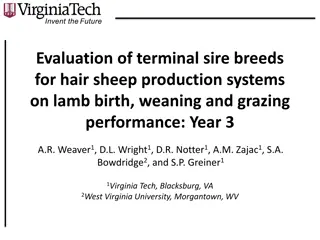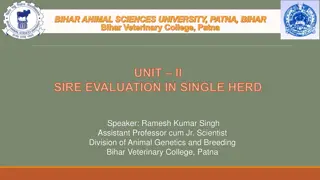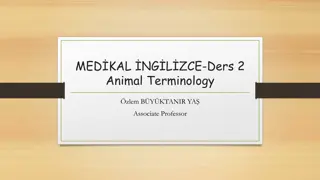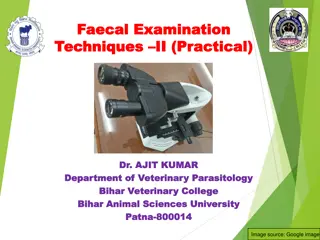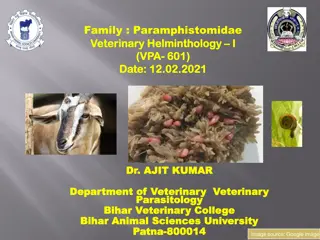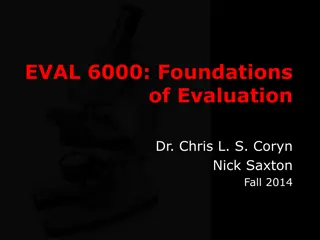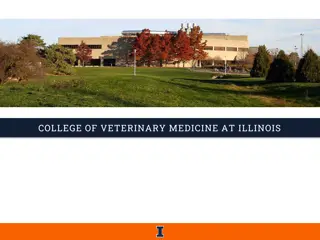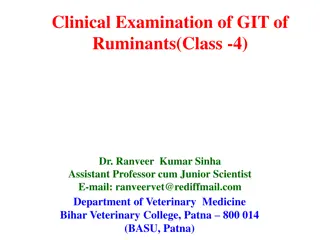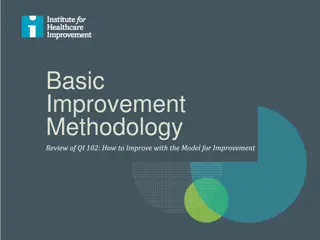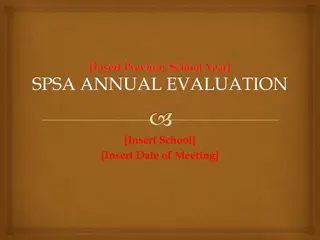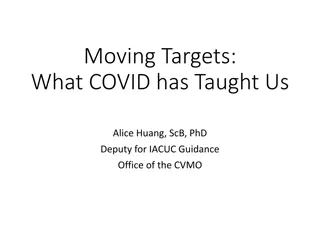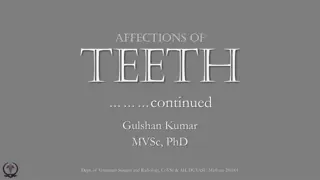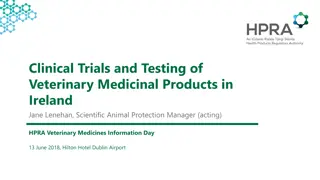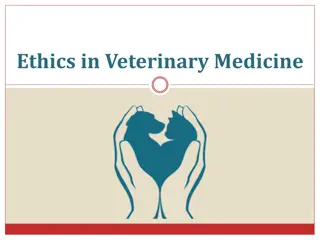Sire Evaluation Methods in Herd Improvement: Insights from Bihar Veterinary College
Explore the methods used for sire evaluation in multiple herds, such as the Dairy Search Index and Corrected Stable-Mate Daughter Average Index, introduced by Ramesh Kumar Singh, an Assistant Professor at Bihar Veterinary College. These methods help estimate the breeding worth of sires and correct for non-genetic effects, offering unbiased comparisons between daughters and contemporaries in organized farm conditions.
Download Presentation

Please find below an Image/Link to download the presentation.
The content on the website is provided AS IS for your information and personal use only. It may not be sold, licensed, or shared on other websites without obtaining consent from the author. Download presentation by click this link. If you encounter any issues during the download, it is possible that the publisher has removed the file from their server.
E N D
Presentation Transcript
BIHAR ANIMAL SCIENCES UNIVERSITY, PATNA, BIHAR Bihar Veterinary College, Patna UNIT-II Sire Evaluation in Multiple Herd Speaker: Ramesh Kumar Singh Assistant Professor cum Jr. Scientist Division of Animal Genetics and Breeding Bihar Veterinary College, Patna
INDEXING IN MANY HERDS This method of progeny testing used in the herd improvement is quite suitable for testing sires which have daughters in many herds through artificial insemination. In building this index, advantage taken of the fact that in the very herds where daughters of A.I. bulls under test have given records, there are other females with corresponding records , i.e. stable mates which make records in the same year, excluding daughters of the bull. The average of such level of stable mate records is used in correcting the daughter s average for the unequal level of production in different herd.
DAIRY SEARCH INDEX (SUNDARESAN,1965) / CONTEMPORARY DAUGHTER AVERAGE INDEX SI= A + [n / n+12] [(D CD) b(M CM)] where, A = herd average n = number of daughters D = daughters average M = dams average CD= weighted average of contemporary daughters CM= weighted average of contemporary dams b = regression coefficient This index uses the performance of contemporaries and the variation in the number of daughters in the progeny group in estimating the breeding worth of the sire. It also corrects for the non-genetic effects like year and season. The above index is applicable under organized farm conditions. (Contemporaries are those individuals that are in same year, same season along with the daughters of the bull under test). Here, only daughters of sires in the first lactation 305- day milk yield are taken into consideration
Advantage 1. Age correction are avoided since the daughters and their contemporaries start their first lactation at same age on an average. 2. The daughter average is not influenced by culling and is an unbiased estimate of daughter level 3. Each daughter is compared to her contemporaries in the same herd on the same level of feeding and management, which would seem to be the most rational method of comparison.
CORRECTED STABLE- MATE DAUGHTER AVERAGE INDEX [D - b* (SD - B) B] B = breed average i.e. the average production over all sires and herds of both the daughters and the herds levels _ =the regression of sire s merit (G) on D, _ D = average recorded production of the daughters of the sires in their various herds b* = the intra- sire regression of daughter average on herd level as estimated by the stablemate average _ SD = ni SDi / ni, the mean of SDI a over all the daughter records of the sires in their I I various herds B = breed average i.e. the average production over all sires and herds of both the daughters and the herds levels
CONTEMPORARY COMPARISON This method is similar to herd mate comparison with additional requirement that a herd mate be of the same age. It was developed by Robertson and his coworkers (1952) for estimating the breeding worth of the sire having daughters in more than one herd. In this method only the first lactation 305 day milk yield is taken for proving the sire. I = + {n / n + k} (D - C) where, n = number of daughters C = average of daughters contemporaries k = ratio of error variance to sire variance
BEST LINEAR UNBIASED PREDICTION (BLUP) This was developed by C.R Henderson (1973), which is the most efficient method of sire evaluation. BLUP can be used with different models to predict breeding values and estimate environmental effects. The properties of the BLUP procedure are as fallows; Best: Maximizations of the correlation between the true breeding g values and predicted values, Linear: Predicted breeding values are linear function of the observations, Unbiased: Estimates of fixed effects are unbiased and the unknown, true breeding values are distributed about the predicted breeding values. Prediction: The producer predicts the true breeding values. BLUP is generally used to predict sire breeding values given measurements on progeny, or to predict breeding values of animals with repeated records, or to predict breeding values of all animals in the pedigree.
The Models are as follows 1. Sire model 2. The repeatability model 3. Individual animal model In conventional method if adjustment factors are estimated, the breeding value will be estimated by two step Applying appropriate adjustment factors to each original record. Calculating the estimated breeding values of each sire using I=biCi Where , Ci is the average adjusted performance of all daughters of a given sire and bi is the appropriate Index weight. It estimates expected breeding value (EBV) of sire by adjusting 1. The data for herd, 2. Year , 3. Season effects, 4. The information provided by the daughters, 5. Information from other relatives. Used in estimating the breeding values.
Animals across contemporary groups can be also compared. It provides estimates of breeding values of many sires born in different years and different locations simultaneously and also provides the estimates of response to selection. BLUP also accounts for complications such as non random mating, environmental trend over time, bias due to culling and selection.


